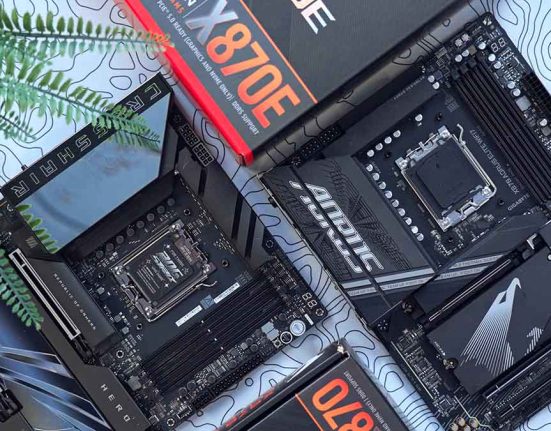The ASUS ROG Strix B850-F Gaming WiFi has hit the shelves, specifically geared towards those building a Ryzen 9000 gaming PC on a budget. This board features a well-rounded but more restrictive set of features compared to the X870 and X870E chipsets, allowing ASUS to offer a competitive price. High-speed DDR5 support, blazing-fast Gen5 storage slots and a bountiful set of rear IO are just a few of the many great features on the ROG Strix B850-F Gaming WiFi. But we’ve put it through the wringer with plenty of testing and analysis to see how it compares to the current lineup of boards.
The B850 chipset offers a starting point for those building a PC on a tighter budget. Not too dissimilar from B650 motherboards, B850 options bring refined features that arrived with the new generation of CPUs, but there are generally fewer of them. This means fewer high-speed ports, less Gen5 expansion and slightly weaker CPU and RAM overclocking capabilities. The result is that B850 is a considerably cheaper alternative for those wanting to make the most out of Ryzen 9000.
In this review, we’ll examine the ASUS ROG Strix B850-F Gaming WiFi in depth, assessing its specs, design, expansion, connectivity options, and features. This will give us a good overview of how it compares to the alternatives.
Buy the ASUS ROG Strix B850-F Gaming WiFi on:
Specification
Looking at the specs, the ROG Strix B850-F Gaming WiFi looks to be a pretty well–rounded board. The first point to note is that there isn’t a point of comparison on the B650 chipset, only B650E, so this is a first for ASUS. This ATX option clocks in at 8000MT/s on the RAM, which is decent considering the price of this board.
CPU VRM power phases are slightly weaker than some of the X870 motherboards we’ve reviewed, but you’ll still be able to sustain a decent overclock with the right CPU pairing. Overclocking isn’t restricted to the flagship chipset with the AM5 platform, which is a big bonus if you’re looking to squeeze out more performance.

On the front IO, you’ll find a fairly standard selection of headers. One USB 3.2 Gen2x2 Type-C header and one USB 3.2 Gen2 Type-A header supports up to two USB 2.0 ports. It’s no surprise to see only four USB headers based on the price of this motherboard, but it would be great if there were a couple more just to flesh out the options, especially for builders with plenty of fans and CPU coolers.
Moving onto expansion, most slots and ports are underneath the large heatsinks on the board. The main Gen5 M.2 SSD sits just below the heatsink close to the CPU socket. This slot is toolless, so it makes disassembly and installation reasonably straightforward. Below is the primary graphics card slot running at Gen5 speeds, ready for NVIDIA’s RTX 5000 range of GPUs. Further down are the two remaining heatsinks, which can be removed with a Phillips head screwdriver. Here are four M.2 slots, two for Gen5 NVMe SSDs and two for Gen4 drives.
| Specification | ASUS ROG Strix B850-F Gaming WiFi |
|---|---|
| Form Factor | ATX |
| Supported Memory | 192GB DDR5 8000MT/s |
| PCI-E x16 Slots | 1 x PCI-E 5.0 1 x PCI-E 4.0 |
| PCI-E x4 Slots | 2 x PCI-E 5.0 2 x PCI-E 4.0 |
| VRM Power Phases | 16+2+2 |
| Front IO | 2 x USB 2.0 1 x USB 3.2 Gen1 Type-A 1 x USB 3.2 Gen2x2 Type-C |
| Rear IO | 4 x USB 2.0 4 x USB 3.2 Gen1 Type-A 2 x USB 3.2 Gen2 Type-A 1 x USB 3.2 Gen2 Type-C 1 x USB 3.2 Gen2x2 Type-C |
| Audio | 1 x Optical S/PDIF 2 x Audio Jacks |
| Networking | 2.5 Gigabit LAN WiFi 7 |
The rear IO selection on this motherboard is fairly strong, with twelve ports, four of which are USB 2.0 and the rest high-speed. I’m glad there are a reasonable number of USB ports to choose from, but the obvious caveat is that there are more slower ports on offer. While this won’t be a deal-breaker for everyone, we understand it won’t appeal to some builders.
Regarding networking, gamers can choose between WiFi 7 and 2.5 Gigabit LAN. It’s great to see the inclusion of WiFi 7, as this networking standard offers much better stability than WiFi 6E. For audio, this board features two 3.5mm audio jacks and optical S/PDIF. Unfortunately, most new motherboards released over the past year or so aren’t as equipped in terms of audio options. Still, the S/PDIF port is a solid value add for those with speaker setups or a soundbar.
What’s in the Box?
Before delving into the overall design and aesthetic of the ROG Strix B850-F Gaming WiFi, we’ll delve into the box accessories to see what ASUS has included. It’s typical for manufacturers to offer additional gadgets as these often ease the building process. Unfortunately, as this is a cheaper motherboard, there aren’t as many accessories compared to X870 motherboards, but there are still a couple of things worth highlighting.
The first is the WiFi antenna. WiFi 7-supported motherboards utilise a clip-in connector instead of screws, making the antenna much easier to install or remove. You’ll need to get this plugged in to make full use of the strong WiFi 7 speeds and range.

This board comes with the M.2 slide, a tool-less accessory for installing M.2 drives. This is useful if you’re looking to install M.2 SSDs without any screws.

The rest of the gadgets included with this motherboard are basic but still useful. You’ll find two SATA data cables used for any 2.5-inch and 3.5-inch SATA drives. ASUS also provides additional cable ties to streamline the cable management process.

ASUS ROG Strix B850-F Gaming WiFi Design
The ROG Strix B850-F Gaming WiFi is a familiar but good-looking motherboard. Unsurprisingly, it is entirely black, similar to its B650E counterpart. The entire motherboard, including the PCB, is black.

There are three removable heatsinks on this motherboard. One at the top, which uses a tool-less latch. The other two are held in by small Phillips head screws providing access to the SSD slots underneath. Each heatsink features various ROG Strix livery, adding a touch of colour and a unique aesthetic to the board.

On top of the rear IO heatsink is a small RGB panel. The lighting in this area is fully addressable, allowing builders to customise and sync it up with other component lighting through an application like SignalRGB.
It’s a shame that not all heatsinks are tool-less. We noted this during our coverage of the X870 range, and it seems to have continued with the B850 series. Ultimately, this won’t be an issue for everyone; providing slots that don’t require tools just adds to the user experience.
Connectivity Options
Graphics Card Slots
Moving onto connectivity and expansion, the ASUS ROG Strix B850-F Gaming WiFi features two PCI-E x16 slots. The primary slot for graphics cards runs at full x16 speeds, and utilises Gen5 bandwidth, equipped and ready for the next generation of graphics cards.

The slot features a standard PCI-E bracket rather than a button, which likely hasn’t appeared due to cost-saving measures. It’s also worth highlighting that this board doesn’t feature additional PCI-E power, which will be a limiting factor for those looking to build a productivity hybrid gaming PC. The bottom slot on this motherboard is a Gen4 slot running at x4 speeds, which can be helpful for those looking to secure to add extra expansion options such as Thunderbolt 4 ports or extra NVMe storage.
M.2 Slots
Underneath the main heatsink is a Gen5 M.2 slot. This motherboard has four slots: two Gen5 and two Gen4. The three additional slots are beneath the other heatsinks, which can be removed with a screwdriver.

While it’s great that there are multiple Gen5 SSD slots, it’s a shame that this board only offers three slots in total. The ROG Strix range of components is generally more expensive than their TUF and Prime counterparts, so an additional slot would add significant value to this pricier board.

RAM DIMMs
RAM is an area that’s seen a fair amount of improvement with the arrival of Ryzen 9000. And while the ROG Strix B850-F Gaming WiFi RAM speeds aren’t as potent compared to X870 options, they’re still solid. This board supports a max capacity of 192GB, clocking in at <>MT/s speeds, providing extra performance in certain applications and games.

Rear IO
The ROG Strix B850-F Gaming WiFi’s rear IO makes it stand out compared to cheaper B850 motherboards. It has twelve ports: four USB 2.0, four USB 3.2 Gen1 Type-A, three USB 3.2 Gen2 ports, and a single USB 3.2 Gen2x2 Type-C port. There’s no Thunderbolt4, but this is to be expected, as the ROG Strix B850-F Gaming WiFi targets the mid-range and budget side of the market.

As for the rest of the rear IO, gamers can leverage WiFi 7 and 2.5 Gigabit LAN for networking, which offer incredibly high speeds. There are also two 3.5mm jacks and optical S/PDIF. Overall, the rear IO selection is very solid, and there’s great value with the ports on offer.
Internal Headers
CPU and Motherboard Power
The power configuration on this motherboard is not particularly interesting. Again, because this board targets builders looking to configure a cheaper system, it isn’t geared toward high overclocking capabilities, so it doesn’t feature additional power headers. At the top left of the board, you’ll find two 8-pin EPS CPU headers. Plugging in both spreads power delivery better and helps with overclocking.

On the right-hand side is motherboard power, which uses the standard ATX 24-pin configuration. There isn’t an additional four or six-pin connector, typically used to provide power for front USB-C.

Front USB Headers
The front USB on the ROG Strix B850-F Gaming WiFi is basic, with four headers in total. On the right are USB 3 and USB-C. The USB-C port offers 20Gbps speeds, while the two ports supported through the USB 3.0 headers are 5Gbps. The remaining USB 2.0 headers are at the bottom of the PCB, next to the CMOS battery.

As we’ve said in other motherboard reviews, an extra USB 2.0 header would be great here. Fans and CPU coolers are using USB 2.0 headers for data transmission now more than ever, so more headers will free up space for future upgrades.
Pump and Fan Headers
There are six headers to plug in any fans and CPU coolers. Starting at the top of the motherboard just above the RAM, you’ll find ‘CPU_Fan’ and ‘CPU_Opt’. Both have a small rubber protector covering the pins, which is a nice touch.

The remaining four are at the bottom of the motherboard. These are all ‘CHA_Fan’ headers. Two are on the left underneath the second PCI-E slot, the third sits next to a USB 2.0 header, and the final is next to the JFP1 front panel power. Six headers is a good number. It would be nice to see one of these connectors at the top of the motherboard, which would help streamline cable management.

RGB Headers
RGB support on the ROG Strix B850-F Gaming WiFi is common. There are three headers on this motherboard, all of which use the 3-pin ARGB standard, which allows you to configure individual LEDs with supporting software. You’ll see one at the top right near the fan headers and two towards the bottom left underneath the PCI-E slot.

Ultimately, it would be ideal to have four or five, but three will be ample for most builders. If you have plenty of RGB components, we recommend using splitters or picking up a case with an integrated hub to free up some of these headers on the board.
Building with the ROG Strix B850-F Gaming WiFi
Fortunately, although this is a cheaper motherboard than X870 options, it’s still a solid board to build. There are a few tool-less features, such as the top SSD slot and the latches underneath the heatsinks that are screwed into the board, simplifying NVMe M.2 installs.
The inclusion of reset CMOS and BIOS flashback is handy for troubleshooting and diagnosis, allowing you to make quick fixes without needing additional tools or an extra CPU. The motherboard feels sturdy and robust, and the range of heatsinks around the VRMs and across other hot components ensures the board stays cool. Overall, the ROG Strix B850-F Gaming WiFi is great to build with.
Features We Like
Solid Rear IO Selection
As we highlighted above, this motherboard’s rear IO is one of its standout features. It has a solid selection of ports, most of which are high-speed. Although the rear IO has been bulked out with USB 2.0 ports, these can be used for peripherals, while the rest can be reserved for devices that need solid transfer speeds.

Gen5 Support
One of the caveats of B650 motherboards is that most of them lacked Gen5 SSD slots or only had one. However, the ROG Strix B850-F Gaming WiFi features support for two PCI-E 5.0 drives, which is great to see.

Features We Don’t Like
Not Fully Tool-Less
One of the caveats of the ROG Strix B850-F Gaming WiFi is that it isn’t entirely tool-less. ASUS has provided a few handy features to streamline the building process, but a screwdriver is still required. This is disappointing, as similarly priced MSI and Gigabyte motherboards are better equipped with DIY-friendly features.

Would Benefit from More USB 2.0 Headers
Having more USB 2.0 headers would be beneficial, as more fans and coolers use them to transmit data such as temperature information to their respective software.

Conclusion
ASUS ROG Strix B850-F Gaming WiFi
Product Name: ROG Strix B850-F Gaming WiFi
Brand: ASUS
-
Features
-
Design
-
Performance
-
Value for Money
Summary
The ASUS ROG Strix B850-F Gaming WiFi is a solid motherboard with well-rounded features. The rear IO is particularly standout on this board, as it has twelve ports, allowing you to plug in numerous peripherals and external devices. ASUS also hasn’t forgotten about expansion, with the ROG Strix B850-F Gaming WiFi offering two Gen5 SSD slots and two Gen4 slots for plenty of additional drives. The overall design is sleek, and the customisable RGB on the rear IO heatsink adds a unique flair to your build.
In terms of weaknesses, there’s not much to cover. This board would benefit from extra USB 2.0 headers and more audio ports on the rear IO, but these are relatively small caveats. My one qualm is the half-measures approach to being DIY-friendly. Not all slots are tool-less, which is somewhat frustrating considering similar boards from Gigabyte and MSI employ a fully tool-less approach. However, if you’re looking to pick up a competitively priced motherboard for your Ryzen 9000 CPU, the ROG Strix B850-F Gaming WiFi is an option we’d recommend considering.
Pros
✅ Bountiful rear IO
✅ Gen5 SSD support
✅ Sleek aesthetic
Cons
❌ Not entirely tool-less
❌ Few USB 2.0 headers
❌ Limited audio support


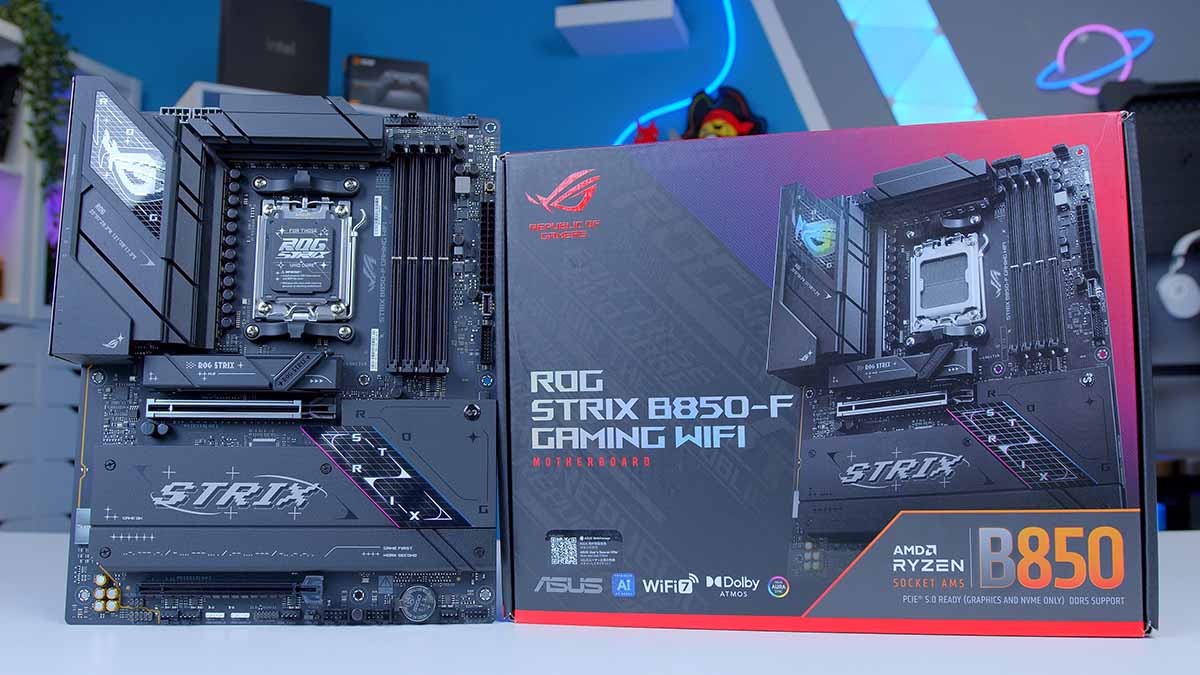
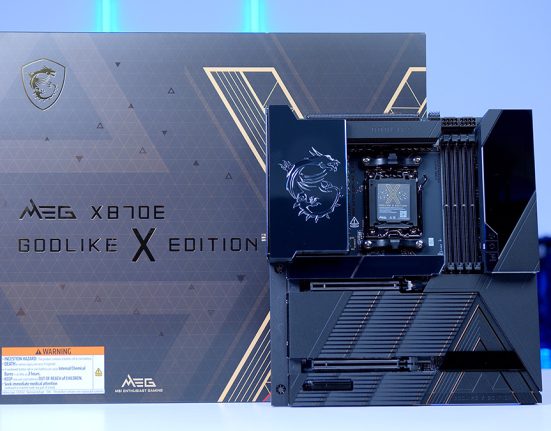
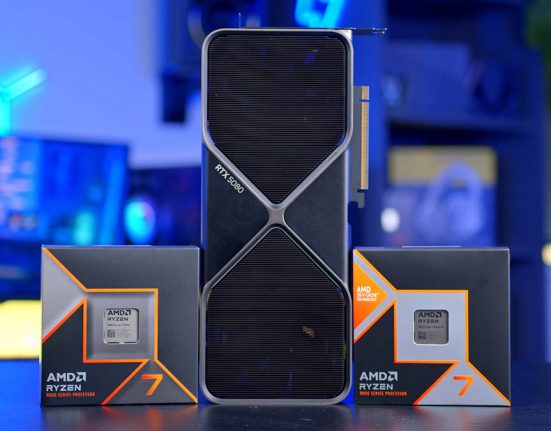
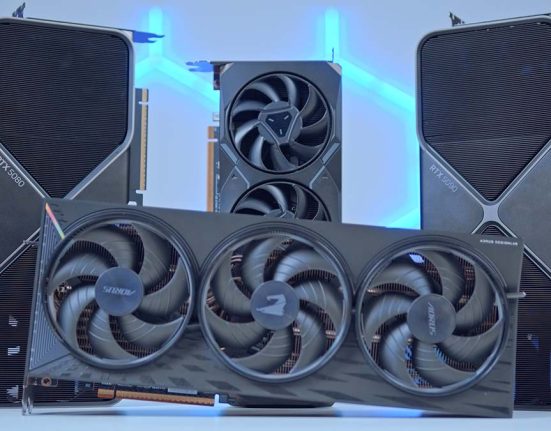
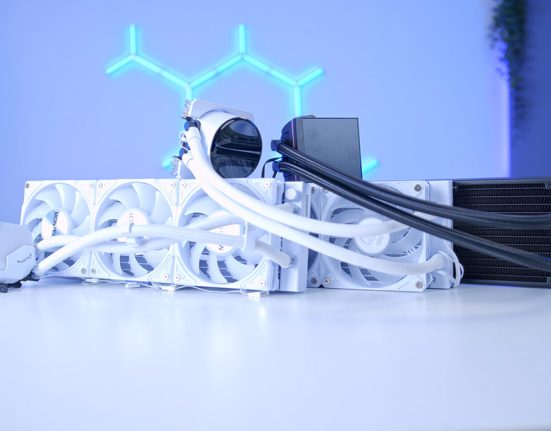
![MPI_[DP055] SAMA V60 + 9070 Build Montage](https://geekawhat.com/wp-content/uploads/2025/12/FI_DP055-SAMA-V60-9070-551x431.jpg)
